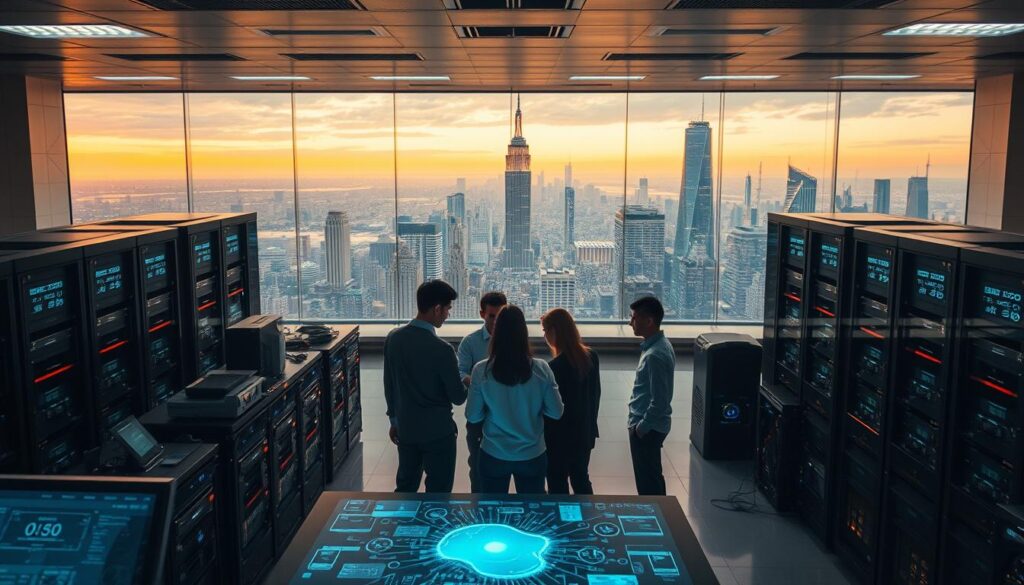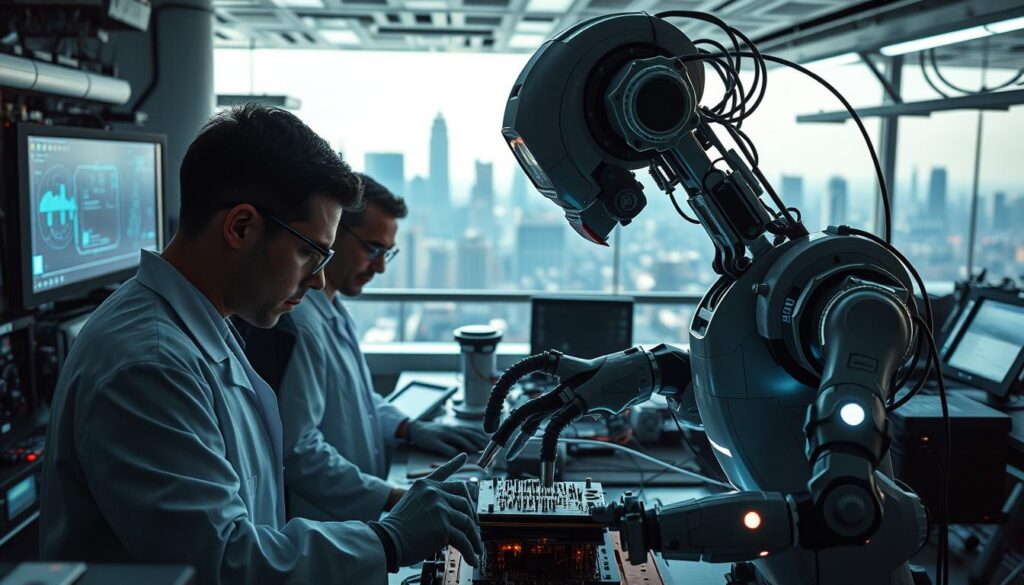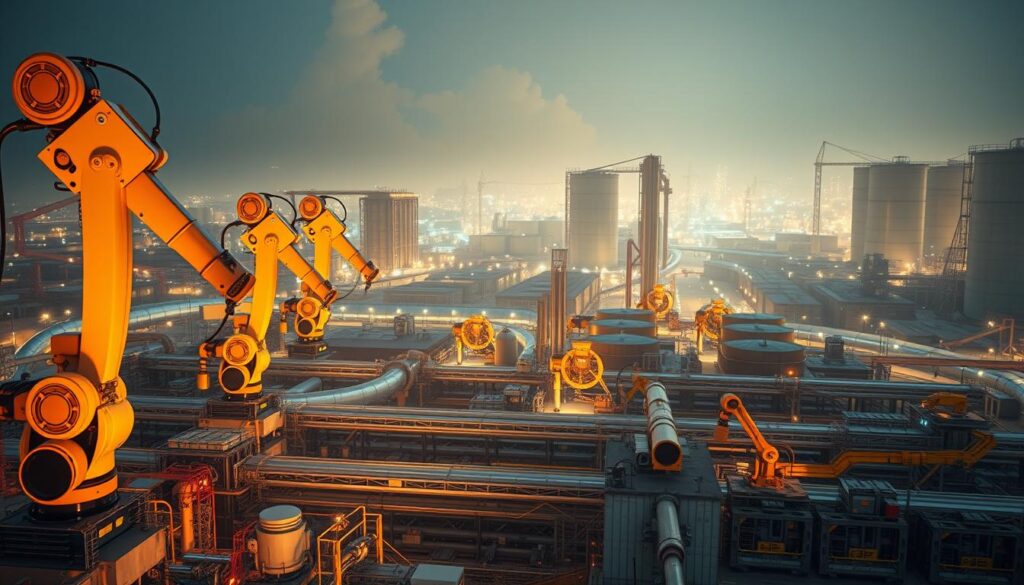“The future belongs to those who believe in the beauty of their dreams.” – Eleanor Roosevelt. This quote resonates deeply as we witness the rapid evolution of artificial intelligence (AI) across the globe. From transforming industries to reshaping daily life, AI is no longer a distant dream but a present reality.
In recent years, the tech landscape has seen groundbreaking innovations. Companies are leveraging AI to enhance services, reduce costs, and drive efficiency. For instance, DeepSeek’s launch has sparked widespread adoption among firms in sectors ranging from automotive to home appliances, offering performance comparable to Western competitors at a fraction of the cost1.
This technological race is not just about innovation but also about leadership. With significant investments in AI, the global market is witnessing a shift. The Bank of China has pledged 1 trillion yuan over the next five years to strengthen the AI supply chain2. Such moves highlight the strategic importance of AI in shaping the future.
As we delve deeper into this article, we’ll explore how AI is transforming industries, the competitive dynamics, and what this means for businesses worldwide. Stay tuned to uncover the full story behind this technological revolution.
Key Takeaways
- AI is reshaping industries with innovations that enhance user experiences.
- DeepSeek’s technology offers high performance at a lower cost compared to Western models.
- Significant investments are driving the rapid advancement of AI globally.
- Companies like Geely Auto and Midea are integrating AI into consumer products.
- The global AI race is intensifying, with strategic investments shaping the future.
Introduction: Charting the New Era of AI in China

The landscape of technology is undergoing a seismic shift, driven by rapid advancements in artificial intelligence. This transformation is reshaping industries, creating new opportunities, and setting the stage for a competitive global race.
Overview of Recent AI Developments
Recent years have seen remarkable progress in AI technologies. Voice assistants in smartphones have become more intuitive, and AI integration in vehicles is enhancing safety and efficiency. These advancements are powered by homegrown models like DeepSeek, which are setting new performance benchmarks3.
Companies are leveraging AI to improve services and reduce costs. For instance, over 4,300 firms contribute to the AI industry, with AI-influenced revenues doubling between 2018 and 20213. This growth is expected to continue, with AI-influenced revenues projected to reach 36% by 20243.
Significance of Innovation and Investment
Innovation is at the heart of this transformation. Significant investments by both private companies and the government are driving these advancements. The AI industry is valued at over $70 billion as of 2025, with plans to expand to $140 billion by 20303.
Government initiatives are also playing a crucial role. The AI standards framework aims to impact at least 1,000 technology companies by 20263. Additionally, the country plans to contribute to the development of over 20 international AI standards3.
| Key AI Developments | Impact |
|---|---|
| Voice Assistants | Improved user experience in smartphones |
| Vehicle Integration | Enhanced safety and efficiency |
| Homegrown Models | Set new performance benchmarks |
| Government Initiatives | Drive industry standards and growth |
For more insights on how AI is revolutionizing industries, check out our detailed analysis on AI tools.
DeepSeek: Driving Innovation in China’s AI Ecosystem

The rapid adoption of advanced technologies is reshaping industries worldwide. At the forefront of this transformation is DeepSeek, a company that has become a key player in the tech ecosystem. Its innovative solutions are not only efficient but also cost-effective, making them accessible to a wide range of industries4.
Revolutionizing Consumer Products and Services
DeepSeek’s impact on consumer products is undeniable. Its advanced voice control systems and mapping functions in vehicles have set new standards for user experience. For instance, major firms like Huawei have integrated DeepSeek’s technology into their smartphones, enhancing functionality and user satisfaction5.
These innovations are not just about convenience. They represent a shift in how technology is applied to everyday life. By offering solutions that are 13 times cheaper than Western models, DeepSeek is democratizing access to cutting-edge tech4.
Integration in Healthcare, Automotive, and Public Sectors
DeepSeek’s applications extend beyond consumer products. In healthcare, nearly 100 hospitals are using its technology to streamline diagnostics and treatment processes. This integration is improving efficiency and accuracy, ultimately benefiting patients5.
In the automotive sector, brands are leveraging DeepSeek’s large language model to enhance safety and navigation. Public sectors are also adopting these solutions to improve service delivery and operational efficiency4.
DeepSeek’s rise reflects a broader trend in the industry. Its ability to deliver high-performance models at a fraction of the cost is reshaping global competition. For more insights, explore how DeepSeek’s disruption in the AI race is influencing the tech landscape.
Exploring the Impact of china ai on Industrial Applications

The integration of advanced technologies is revolutionizing industrial applications. From manufacturing to automotive sectors, AI is driving efficiency and innovation, reshaping traditional practices and setting new benchmarks.
Transformations in Manufacturing and Automotive Technologies
AI is transforming manufacturing by optimizing production lines and reducing production times. For instance, the use of industrial robots has increased by 13% since 2017, enhancing precision and efficiency6.
In the automotive sector, AI-powered systems are improving safety and navigation. Level 3 and higher autonomous driving is expected to achieve a 56% penetration rate by 20307. These advancements are not just about convenience but also about redefining industry standards.
Research and Development in State-Sponsored Institutions
Government-backed projects are accelerating R&D efforts in key areas like semiconductor technology. Institutions like Fudan University are leading breakthroughs in integrated circuits, supported by a 10% increase in national R&D spending6.
These initiatives are fostering innovation and competitive strategy within the industrial sector. By leveraging technological performance, the country is gaining a competitive edge in both domestic production and global exports8.
| Key Industrial Applications | Impact |
|---|---|
| Manufacturing | Optimized production lines, reduced production times |
| Automotive | Enhanced safety and navigation systems |
| Semiconductor R&D | Breakthroughs in integrated circuits |
For more insights on how AI is reshaping industries, explore our detailed analysis on AI tools.
Baidu’s Response: Competitive Strategies and Open-Source Shifts
Baidu is making strategic moves to stay competitive in the fast-paced tech industry. The company has introduced free-to-use models and shifted towards open-source strategies to keep up with innovations led by competitors like DeepSeek9.
Evolution from Ernie Bot to Next-Generation Models
Baidu’s journey began with Ernie Bot, its first generative platform launched in 2023. However, the model was quickly overshadowed by competitors such as Alibaba and ByteDance9. To regain its edge, Baidu developed the ERNIE X1 reasoning model, which promises performance comparable to DeepSeek R1 at half the cost9.
This new model is designed to tackle complex problems by breaking them into smaller tasks, mimicking human reasoning9. Such advancements highlight Baidu’s commitment to enhancing its technology and staying relevant in the market.
Adopting Open-Source Initiatives for Broader Innovation
Baidu’s shift to open-source is a game-changer. Starting June 30, 2025, the company plans to make its next-generation Ernie model open-source10. This move aims to foster broader innovation and collaboration within the industry.
Open-source strategies allow developers to access and improve the technology, accelerating its development and application across various sectors9. However, Baidu faces challenges, including regulatory hurdles and underestimating market dynamics, which have slowed its progress10.
| Key Strategies | Impact |
|---|---|
| Free-to-Use Models | Increased accessibility and adoption |
| Open-Source Transition | Fosters innovation and collaboration |
| ERNIE X1 Reasoning Model | Enhances problem-solving capabilities |
Baidu’s efforts reflect a broader trend in the industry, where companies are leveraging open-source models to drive innovation and competitiveness. For more insights on how these strategies are shaping the future, explore our detailed analysis on AI tools.
Global Implications and the Future of AI Leadership
The global race for technological dominance is reshaping industries and policies worldwide. As nations compete for leadership in innovation, the stakes have never been higher. This competition is not just about economic growth but also about setting the standards for future technologies.
US-China Tech Competition and Policy Impact
Export controls and policies are playing a pivotal role in shaping the tech race. For instance, restrictions on advanced semiconductors have created challenges for firms aiming to develop cutting-edge models11. These measures highlight the strategic importance of controlling key technologies in the global market.
Government initiatives are also driving innovation. The Chinese government has prioritized sectors like smart manufacturing and autonomous vehicles, aiming to strengthen its position in the global tech chain11. Such strategies are reshaping the competitive landscape and influencing international relations.
Emerging Trends in Data, Chips, and Industrial Integration
Advancements in data processing and chip production are setting new benchmarks. Companies are leveraging these innovations to enhance efficiency and reduce costs. For example, Huawei Cloud’s Ascend service has significantly reduced large model training time, showcasing the potential of integrated solutions12.
Industrial integration is another key trend. Smart manufacturing and AI-driven applications are transforming traditional practices. These developments are not only improving productivity but also positioning China as a leader in the global tech industry12.
As the competition intensifies, the future of tech leadership will depend on strategic investments and collaborative efforts. For more insights on how these trends are shaping the global landscape, explore our detailed analysis on AI rivalries.
Conclusion
The future of global tech leadership is being reshaped by rapid advancements and strategic innovations. Companies like DeepSeek and Baidu are driving this transformation, offering high-performance models at competitive costs13. Their efforts highlight the growing influence of innovation in shaping industries and markets.
Government initiatives are also playing a crucial role. By investing in key sectors like manufacturing and technology, the Chinese government is strengthening its position in the global tech chain14. This strategic focus is setting new benchmarks for leadership and control in the industry.
The race for dominance is not just about technology but also about strategy. Firms are adopting open-source models and optimizing resources to stay ahead13. These moves are reshaping the competitive landscape and influencing global dynamics.
As we look ahead, the integration of advanced applications and services will continue to define the future. For more insights on these developments, explore our detailed analysis on global tech leadership.
FAQ
What recent advancements has China made in artificial intelligence?
How is DeepSeek contributing to the AI ecosystem in China?
What role does the Chinese government play in AI development?
How is Baidu responding to the competitive AI landscape?
What are the global implications of China’s AI leadership?
How does AI impact manufacturing and automotive technologies in China?
What are the key trends in AI research and development in China?
Source Links
- How Innovative Is China in AI?
- Beyond DeepSeek: How China’s AI Ecosystem Fuels Breakthroughs
- Beijing embraces DeepSeek to lead AI adoption as it looks for new growth drivers
- China’s DeepSeek and its Open-Source AI Models
- Assessing China’s AI development and forecasting its future tech priorities
- How AI is shaping industries in China | J.P. Morgan Research
- Exploring China’s Leading AI Hubs: A Regional Analysis
- Baidu, once China’s generative AI leader, is battling to regain its position
- Is Baidu Waiting for a Return to the Top of China’s Tech Sector?
- AI Rivalries: Redefining Global Power Dynamics
- China And AI In 2025: What Global Executives Must Know To Stay Ahead
- China vs. U.S. in AI: Who’s Winning the AI Race?
- China banks on open source in AI cold war with US







